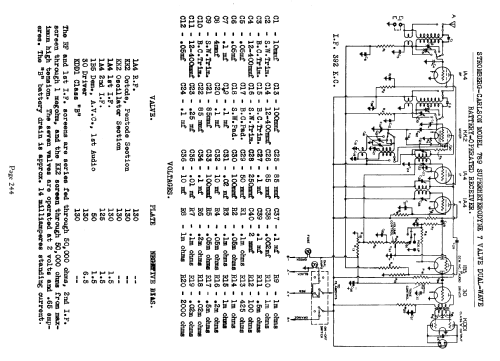- Country
- Australia
- Manufacturer / Brand
- Stromberg-Carlson (Australasia) Pty. Ltd. Sydney
- Year
- 1937
- Category
- Broadcast Receiver - or past WW2 Tuner
- Radiomuseum.org ID
- 165398
Click on the schematic thumbnail to request the schematic as a free document.
- Number of Tubes
- 7
- Main principle
- Superhet with RF-stage; ZF/IF 392 kHz; 3 AF stage(s)
- Tuned circuits
- 7 AM circuit(s)
- Wave bands
- Broadcast and Short Wave (SW).
- Power type and voltage
- Storage and/or dry batteries / 135 & 2 Volt
- Loudspeaker
- Permanent Magnet Dynamic (PDyn) Loudspeaker (moving coil) / Ø 10 inch = 25.4 cm
- Material
- Wooden case
- from Radiomuseum.org
- Model: 789 - Stromberg-Carlson Australasia
- Shape
- Console, Lowboy (legs < 50 %).
- Notes
-
Model 789 Stromberg-Carlson Seven-Valve DW battery powered Superhet.
High sensitivity and low noise level are outstanding features of the latest Model 789 Stromberg-Carlson seven-valve dual-wave release.
Exceptionally high sensitivity is assured by the use of a 1A4 as RF amplifier, and of two stages of intermediate frequency amplification (also using 1A4's). A KK2 is used as a mixer, with a 1B5 as a second detector, AVC, and first audio stage feeding a 30 driver with a KDDI as class "B" power output stage.
Throughout the entire design, particular attention has been paid to keeping current consumption as low as possible. A special switch is also incorporated, enabling the dial lights to be extinguished when the set is in operation, further reducing battery drain.
An edge-lit vertical straight line tuning dial, identical to that used in the eight and nine valve A.C. receivers, is fitted. The stations are marked in large clear-cut figures and are divided vertically into States, while the four international overseas channels are grouped on the left-hand side of the dial.
The tuning range is from 175-570 metres on the broadcast band and 16.8 to 51 metres on the short waves. A large control knob gives speedy, easy tuning, having dual dial ratios of sixty and ten to one.
A 10" dust-proof permanent magnetic dynamic speaker is fitted, which, combined with the outstanding acoustic properties of the Concert Grand Cabinet, gives the 789 a high degree of tonal quality and faithfulness of reproduction under a wide range of atmospheric conditions and · geographical obstructions.
An additional feature is the variable tone control.
Controls from left to right are as follows:-- On-off and dial lights switch,
- Volume
- Tone
- station selector
- wave changer and gram switch.
Altogether, the 789 is a dual-wave battery receiver that will fill the demand for a deluxe radio for the man on the land.
Australasian Radio World, Sep 1, 1937. Page 36.
- Circuit diagram reference
- Australian Official Radio Service Manual Vol. I
- Mentioned in
- Australasian Radio World, Sep 1, 1937. Page 36.
- Author
- Model page created by Stuart Irwin. See "Data change" for further contributors.
- Other Models
-
Here you find 359 models, 178 with images and 185 with schematics for wireless sets etc. In French: TSF for Télégraphie sans fil.
All listed radios etc. from Stromberg-Carlson (Australasia) Pty. Ltd. Sydney
